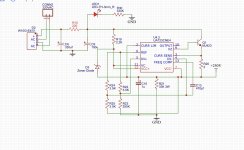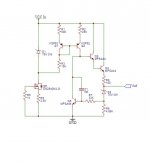Ive also concluded after much breadboarding that the working voltage for the 723 needs to be between 36V and 38V to get the maximum out of the chip operating in positive floating mode,or a HV enviroment in general.
The joy of the LM723 is that you do NOT have to use all of it!
The buried zener on the LM723 is teh special/ unusual/ unobtainable, in modern-form part that is worth atry. When decoupled as suggested in the datasheet (hey, try 10uF) it makes an excellent voltage reference for the discrete regulator you might really want to build. That's a 3-pin hook-up; you can ignore the rest of the part.
- and at that - it, the LM723 and the cap, remains rather cheaper than an LM329, and it is quieter esp at LF / 1/f flicker noise - as Jean-Paul noted above.
The buried zener on the LM723 is teh special/ unusual/ unobtainable, in modern-form part that is worth atry. When decoupled as suggested in the datasheet (hey, try 10uF) it makes an excellent voltage reference for the discrete regulator you might really want to build. That's a 3-pin hook-up; you can ignore the rest of the part.
- and at that - it, the LM723 and the cap, remains rather cheaper than an LM329, and it is quieter esp at LF / 1/f flicker noise - as Jean-Paul noted above.
AFAIK, buried zeners were only made practical several years after the first issue of the 723 (1968, if I am not mistaken), but I could be wrong. There might be confusion between several types: buried, sub-surface, and probably other types....
I appreciate the clarification!
Either way - the 723 is a very old, very -settled process; and - yes- it's still a useful part to play with; certainly ducational, even if you find nothing else beneficial out of it.
Either way - the 723 is a very old, very -settled process; and - yes- it's still a useful part to play with; certainly ducational, even if you find nothing else beneficial out of it.
Definately, the datasheet says 5uf (RC filter)cap on the Vref will yeild a 2 microvolt output noise, that is phenomenal considering the price of the chip, every bit worth it!!The joy of the LM723 is that you do NOT have to use all of it!
The buried zener on the LM723 is teh special/ unusual/ unobtainable, in modern-form part that is worth atry. When decoupled as suggested in the datasheet (hey, try 10uF) it makes an excellent voltage reference for the discrete regulator you might really want to build. That's a 3-pin hook-up; you can ignore the rest of the part.
- and at that - it, the LM723 and the cap, remains rather cheaper than an LM329, and it is quieter esp at LF / 1/f flicker noise - as Jean-Paul noted above.
Last edited:
I will bring up Audio Research again,in particular the SP-8, that power supply has had issues over the years, its a very similar setup, except it uses a discrete op-amp(741) and a LM329 VR, with a control and pass tube, the pass tube(12BH7) has to drop too much voltage for one, thats a first sticking point, the second they could have used the 723 and just added a freg. comp cap, and had a much better regulator, the choice of tubes is fine, the unregulated B+ is way too high for one thing. I never have understood their design philosophy over the years.
I remember seeing this a few years ago.
https://www.diyaudio.com/community/threads/arc-sp8-tube-reg-rebuild.280144/
I remember seeing this a few years ago.
https://www.diyaudio.com/community/threads/arc-sp8-tube-reg-rebuild.280144/
Last edited:
Sometimes illogical choices are made at various brands. It keeps repair men at work. Some think that if a device is made by a brand in a factory it is "original" and should stay like that and any change is lowering the value of the device. Well, I have worked at a brand and have found mistakes/errors that even an amateur does not make. One of them was to have no decoupling caps at all in a device. Sometimes a certain way of designing becomes the "house standard" which makes it easy to find errors in the generations of the devices. Where there are people errors will be made, the important issue is that the errors should come out after the warranty period 🙂
Today devices may have clear and obvious "features" that were applied deliberately and will determine a short lifespan. A good example here are the electrical fans for home use that have a few design features that makes them last only a year. Dyson and Braun have a hand at it too, if one does not believe existence of "planned obsolescence" then one should open a few devices by these brands. I think this technique is worse than unplanned errors and find pleasure finding those errors before the device breaks down because of them.
Today devices may have clear and obvious "features" that were applied deliberately and will determine a short lifespan. A good example here are the electrical fans for home use that have a few design features that makes them last only a year. Dyson and Braun have a hand at it too, if one does not believe existence of "planned obsolescence" then one should open a few devices by these brands. I think this technique is worse than unplanned errors and find pleasure finding those errors before the device breaks down because of them.
Last edited:
Hi Gents, watching this discussion as I'd like to improve the quality of my PSU for my little 4-tube headphone amp (6N1P/6N6P).
Right now I have the toroidal xformer -> bridge (Vishay UF Hexfreds) -> 2x470uF + 10uF film on top of that. Simple. This gives me ~300V DC. Works quite well, dead silent but I might even improve it further. (No measurement equipment, I'm a beginner).
First I was just looking at my handful of LM317T-s and thought how about raising it's GND potential with a diode+cap trick to 280V, making it floating and then the rest (300V -> 290V) could be easily eaten by this regulator.
And now looking at the schematics you just threw in so far: is there any final conclusion I could use and try ?
The amp would normally need 280V but 300 is not an issue either right now, beautiful sound.. I just thought I'm improving the anode voltage part and also my skills and knowledge. 🙂
Right now I have the toroidal xformer -> bridge (Vishay UF Hexfreds) -> 2x470uF + 10uF film on top of that. Simple. This gives me ~300V DC. Works quite well, dead silent but I might even improve it further. (No measurement equipment, I'm a beginner).
First I was just looking at my handful of LM317T-s and thought how about raising it's GND potential with a diode+cap trick to 280V, making it floating and then the rest (300V -> 290V) could be easily eaten by this regulator.
And now looking at the schematics you just threw in so far: is there any final conclusion I could use and try ?
The amp would normally need 280V but 300 is not an issue either right now, beautiful sound.. I just thought I'm improving the anode voltage part and also my skills and knowledge. 🙂
Ive used Maida setups before with the 317, they work ok, but I like this one much better, I would use a 36V zener to power the 723, if you put about 5uf cap on the voltage divider coming off the Vref, this will cut down the ripple to about a 2 microvolts, but since Im using this on a line stage, 20 microvolts is plenty quiet. I know HV TO-3's are kind of expensive, I was able to find a source for the MJ423's, I like using these packages.Hi Gents, watching this discussion as I'd like to improve the quality of my PSU for my little 4-tube headphone amp (6N1P/6N6P).
Right now I have the toroidal xformer -> bridge (Vishay UF Hexfreds) -> 2x470uF + 10uF film on top of that. Simple. This gives me ~300V DC. Works quite well, dead silent but I might even improve it further. (No measurement equipment, I'm a beginner).
First I was just looking at my handful of LM317T-s and thought how about raising it's GND potential with a diode+cap trick to 280V, making it floating and then the rest (300V -> 290V) could be easily eaten by this regulator.
And now looking at the schematics you just threw in so far: is there any final conclusion I could use and try ?
The amp would normally need 280V but 300 is not an issue either right now, beautiful sound.. I just thought I'm improving the anode voltage part and also my skills and knowledge. 🙂
Attachments
Here is my version of the VR amplifer found in the 723, this one simulates well in B2 Spice. the Vref is 75VDC. It may need some tweeking. This could be done on 1"x2" board added to an existing HV power supply, or incorporated into new design.
Attachments
- Home
- Amplifiers
- Power Supplies
- LM329 vs LM723 Voltage Reference

